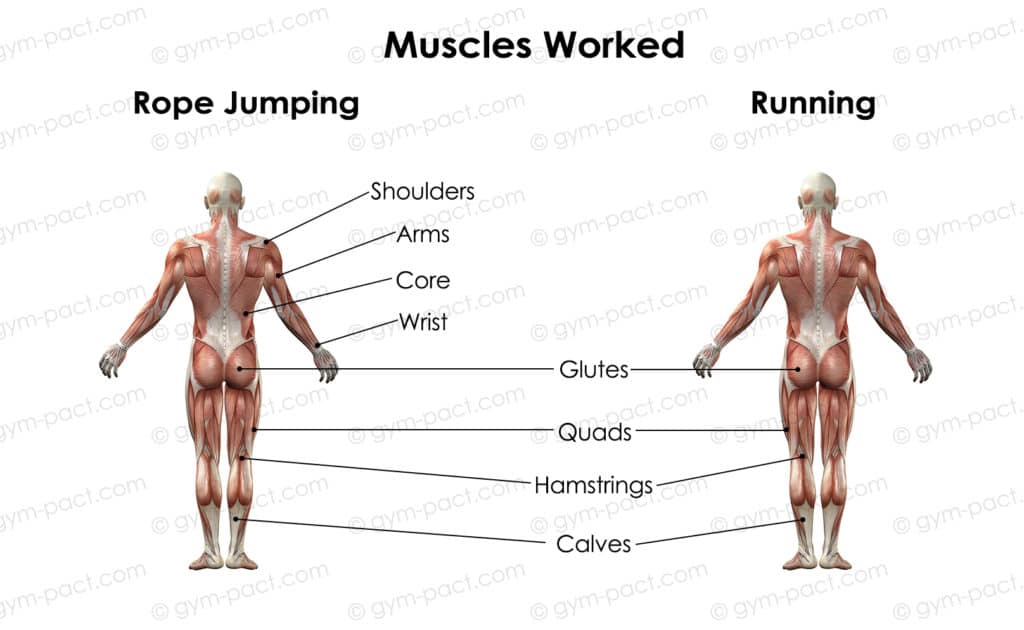You’ll burn about 12 calories per minute from rope jumping. When you run at a moderate pace for a mile, you will burn around a hundred calories, though this may change according to your body weight. So, to burn the same number of calories as you would from running a mile, you would have to be rope jumping for 8 minutes and 20 seconds.
Running vs. Rope Jumping: Calories Burned & Muscles Worked
Both running and rope jumping are excellent aerobic exercise choices for weight loss. They will both improve your heart health and lung capacity, enhance your agility and build strength in the leg muscles, as well as provide numerous health benefits.

On a minute for minute comparison, however, you will burn more calories and achieve a higher heart rate when you jump rope. However, you will not be able to continue skipping for as long as run. Therefore, in an hour of working out, you will probably burn more calories by going for a run than by skipping. That’s because you can’t skip for an hour non-stop.
Let’s look at a comparison.
If you run for an hour non-stop at a pace of 5 miles per hour, you will burn around 500 calories per hour, depending on how much you weigh. Within that time, you would not be able to skip for 60 minutes non-stop. But let’s say that we’re able to jump for 2 minutes and then have a one-minute rest repeatedly. You’d have to be pretty fit to do that for an entire hour, but let’s say you could.
That means that you would do 2 minutes of jumping rope round, twenty times for a total of 40 minutes of skipping in that hour. As we have already found out, rope skipping for a minute burns about 12 calories. You can burn more calories by doing advanced moves like cross-over rope jumps and double skips.
So in an hour jump rope workout (40 minutes of actual exercise), you would burn 12 x 40 minutes, or 480 calories.
We can see from this that the calorie burn from jumping over an hour is pretty close to that derived from running. But doing 20 two-minute rounds of rope jumping with just a minute’s rest between each set is going to be a hard ask for most of us. So running is a more efficient weight-loss method over the long term.
| Activity | Calories burned hour | Muscle Worked |
| Rope Jumping | 480 | Quads, calves, hamstrings, glutes, core, arms, shoulders, wrists |
| Running | 500 | Quads, calves, hamstrings, glutes |

Jump rope exercise will also burn more calories than working out on an elliptical trainer, treadmill, or stepper machine.
So, What’s So Good About Rope Jumping?
Rope jumping is a vigorous activity that provides an excellent amalgamation of plyometric, cardiovascular fitness, agility, and strength training. Here are 8 advantages of jump rope aerobic exercise:
- It churns through between 10 and 14 calories every minute, depending on how much you weigh and how fast you are skipping.
- It improves your balance, coordination, and agility, making you lighter on your feet and more able to correct your balance if you begin to fall.
- It makes an awesome choice if you are wanting to do high-intensity interval training (HIIT) to burn as many calories as possible in the shortest possible time frame.
- It strengthens your wrists, deltoids, arms, erector spinae, and latissimus dorsi muscles.
- It strengthens your core muscles and, of course, your leg muscles.
- It induces the enhanced post-exercise oxygen consumption (EPOC) effect which raises the metabolism for 24-26 hours after exercise.
- It is awesome when super set with resistance training. To increase your fat burn you can alternate back and forth between a set of resistance exercises, like the barbell curl, and then go directly to skipping for 30-60 seconds.
How to Perfect Rope Jumps
To get the most benefit from your rope jumping cardiovascular workout, you need to be doing it properly. Here’s an overview of the proper form on the basic jump:
- Stand with feet close together, your body in an upright position, and holding the rope loosely in your hands with the rope behind your body, arms at your sides. Elbows and knees should be slightly bent.
- Rotate your wrists to bring the rope up over your head. Don’t allow your elbows to sway away from your body.
- As the rope travels overhead and down to your feet, jump both feet slightly in the air. Keep your knees slightly bent and land softly on your toes.
- It improves your hand-eye coordination.
HIIT Rope Jumping
You can increase the calorie burn rate and gain additional benefits by using rope jumping as the exercise that you do in high-intensity interval training (HIIT). High-intensity jump rope sessions will also increase your metabolism for many hours after your workout is finished.
To do HIIT skipping rope workouts, perform high-speed rope jumping for 20 seconds where you go at a very brisk pace. Then pause for exactly 10 seconds. Repeat this pattern eight times. You can use a normal skipping rope for high-intensity interval training.
Final Thoughts
To jump rope for the equivalent calorie burn as running for a mile, you need to be skipping rope for 8 minutes and 20 seconds without a break. However, there are a number of other benefits that come from rope jumping that you will not get from running. These include improving your agility, coordination, and speed on your feet.
Frequently Asked Questions
Is jumping rope bad for the joints?
Jumping rope is not bad for your joints so long as you do the exercise the right way. The biggest cause of ankle or knee pain is lifting your feet too high and coming down too heavily. You should only lift your toes slightly off the floor, bringing your toes up together and coming down softly.
Another potential cause of joint problems with ripe jumping is over-training. That is one reason why boxers jump in short bursts of 2-3 minutes and then take a break. This will give your joints the time to recover between sets.
Is rope jumping better than running on a treadmill?
That depends on what your exercise training goal is. If you are training for a race, then you will always be better off running on a treadmill as it more perfectly simulates the race activity. However, when it comes to losing weight, improving your balance and hand-eye coordination, or improving your cardiovascular fitness you will be better off with rope jumping. Both rope jumping and running is excellent aerobic exercise type.
Can I still do rope jumping if I am uncoordinated?
Yes, you can still do rope jumping if you are uncoordinated, though it will take some time and patience to get good at it. Start without a rope by simply imagining that you have one in your hands. Then progress to a walking skip, slowly working to a faster skip as you go.







